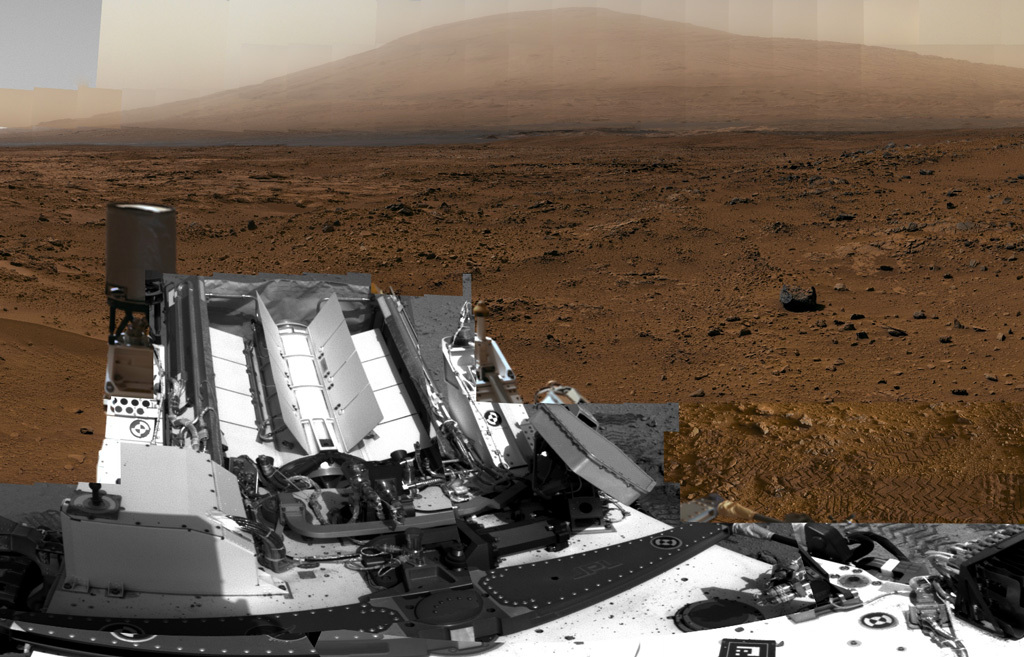Ray Bradbury’s Mars, vividly portrayed in the short stories that grew into his 1951 book The Martian Chronicles, wasn’t the Mars we know, but it has lessons for us nonetheless. At the end of the book, a colonist from Earth takes his children to see the fabled Martians who built the canals that Bradbury — and many others — still thought might exist on the planet. The kids can’t wait to see these legendary beings and run with their father to the side of one of the canals, where he points into the water. Says Bradbury:” The Martians were there—in the canal—reflected in the water…. The Martians stared back up at them for a long, long silent time from the rippling water….”
It’s the children who are the Martians now, and they will grow up as a new branch of humanity. Today we see Mars in spectacular views like a recently released billion-pixel shot from the Curiosity rover, a dry, barren, windswept place without a drop of water in sight. But it’s not inconceivable that Bradbury was right, and not just in a poetic way. For we have studied chunks of Mars that have fallen to Earth in the form of meteorites, and whether or not early life could have been carried inside such a rock from one planet to another remains an open question. Could the microbial ancestors of all Earthly life themselves have been Martians once?
Ancient rocks like these tell quite a tale. One recent study from the University of Hawaii at Manoa identifies boron in one of the Martian meteorites found in Antarctica, an object whose chemical composition clearly shows its Martian origins. The team of researchers was able to study veins of Martian clay embedded within it, finding that boron abundances were ten times higher than in any previously studied meteorite. That’s interesting to astrobiologists, the people who study life’s possibilities on other worlds, because boron in its oxidized form can stabilize ribose, which in turn is a crucial component of RNA, now considered to be the precursor to DNA. Our Earth is loaded with borates, but they’ve never been found on another planet.
 |
|
Mars as seen by the Odyssey spacecraft. Water-carved valleys on the planet appear to have been caused by runoff from precipitation, likely meltwater from snow. Early Martian precipitation would have fallen on mountainsides and crater rims. Credit: NASA. |
Even without leaving Earth, then, we’re learning things about Mars’ composition from a time when the planet was far wetter than it is today. The primordial clays don’t prove that life existed on Mars, but they’re yet more evidence that conditions favoring a key molecular building block of life were present at one time. While we continue to study these Earthly samples of Mars, we also have the ongoing grand tour being accomplished by the Curiosity rover on the Red Planet itself to consider. Curiosity, having thoroughly investigated an area called ‘Glenelg’ that was its first destination after landing, will now be heading southwest for a months-long journey to nearby Mount Sharp, seen looming in the billion-pixel image that Curiosity took in late 2012.
Mount Sharp is some five miles away from the rover’s present position and mission planners don’t know how long the trip will take because they’ll be investigating numerous features along the way. We do know that analysis of several rocks chosen for close study has been hugely successful at identifying how the environment of ancient Mars changed over the eons. Samples from a rock called ‘John Klein’ show that Gale Crater, the surface feature within which Curiosity has been conducting its operations, once had not just sources of energy but low-acid water that could have been a favorable home for microbial life. Sieved and analyzed within the rover, the clay-rich rock sample showed crucial elements like hydrogen, oxygen, carbon, sulfur, nitrogen and phosphorus. Holes have been drilled into another rock, called ‘Cumberland,’ as a check on the ‘John Klein’ findings, in hopes of confirming the area as being once hospitable to life.
 |
|
NASA's Curiosity rover found evidence for an ancient, flowing stream on Mars at a few sites, including the rock outcrop pictured here, which the science team has named "Hottah" after Hottah Lake in Canada's Northwest Territories. It may look like a broken sidewalk, but this geological feature on Mars is actually exposed bedrock made up of smaller fragments cemented together, or what geologists call a sedimentary conglomerate. Scientists theorize that the bedrock was disrupted in the past, giving it the tilted angle, most likely via impacts from meteorites. Image credit: NASA/JPL-Caltech/MSSS. |
Meanwhile, the analysis of earlier observations confirms that pebble-packed slabs of rock that Curiosity studied last year were indeed part of an ancient streambed, with gravels from the size of sand particles to golf balls. What the rover has revealed is the existence of a former stream that was moving, at minimum, at a speed something like that of a fast human walk, a stream that was at least ankle-deep and perhaps as much as a few feet. The findings were startlingly like Earth streambed deposits, the kind of rounded river pebbles we’ve all skipped across water.
When it comes to Mars data, when it rains, it pours. In July, researchers at Brown University were able to use observations by the Odyssey spacecraft, now orbiting the planet, to show that water-carved valleys at four different locations were caused by runoff from what is called ‘orographic precipitation,’ in which moist air is pushed up a mountain slope and falls as snow or rain. Orographic patterns are distinctive enough for researchers like Brown’s Kat Scanlon to model them along with simulations of Martian air circulation, showing where precipitation was likely to fall at the different locations. The predictions matched the Odyssey observations, implying that likely meltwater from snow was a factor in the early Martian environment.
But while we can show conditions were once right for primitive life to form on the planet, we’re not yet able to say that it did, or that its remote descendants may not still be found a few feet under the surface. For that, even more sophisticated rovers are called for, and the kind of field work only a human research team can provide. While we await further developments, Curiosity’s billion-pixel camera view has been placed online, where nearly 900 exposures of its cameras are melded into an image that can be scanned with pan and zoom tools. Unlike Bradbury’s colonist children, we may have no Martian canals to gaze into, but the view of Gale Crater, zoomed and manipulated from a comfortable desk chair, can still make the imagination soar.









